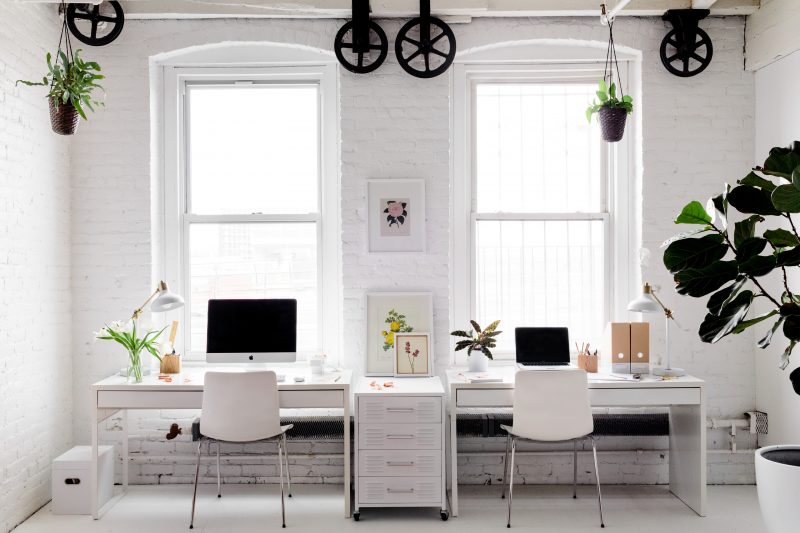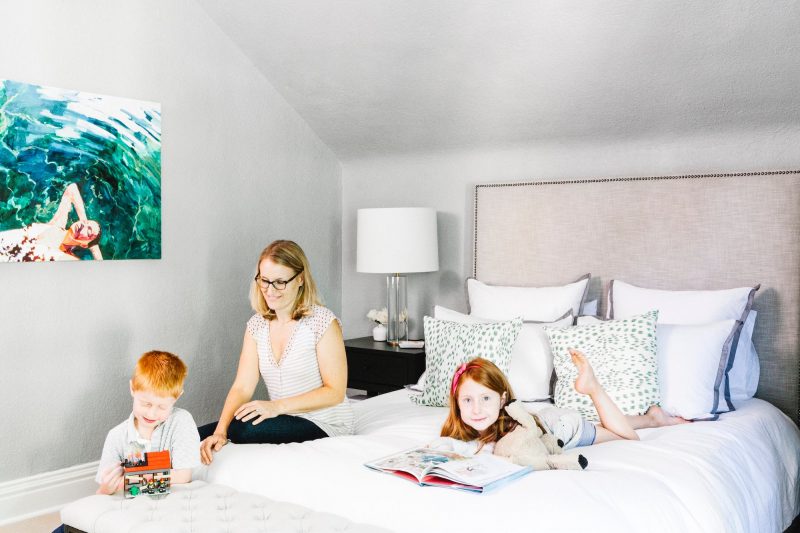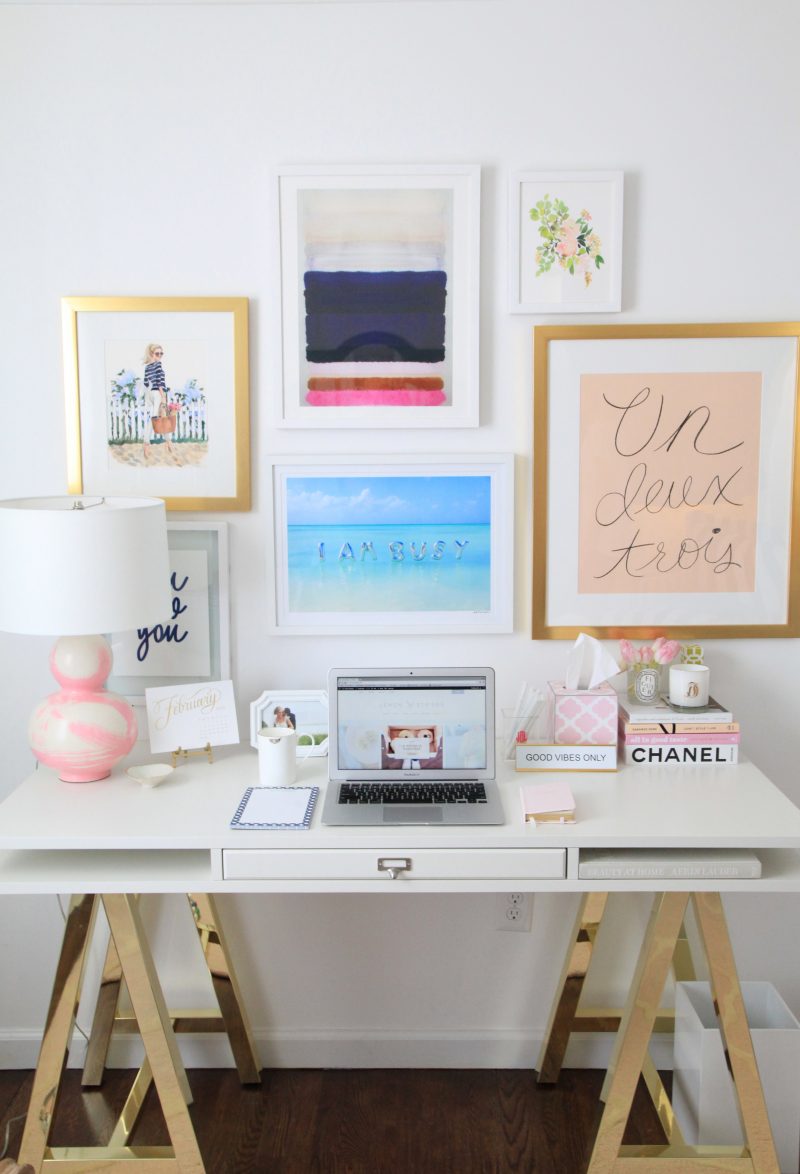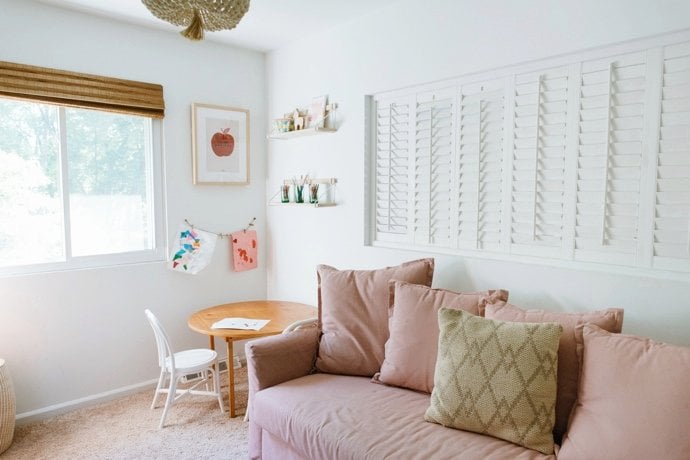Virtual learning for students pre-K through 12th grade. In the words of Aladdin, it’s a whole new world.
If you want to set your child up for virtual learning success, start by setting up your home as the best possible learning environment, in lieu of actually sending them to the classroom.
The overarching objectives of this assignment:
- Create an organized space for better focus
- Create an attractive space that inspires
- Create a screen-friendly space (follow along below for directions)
Here are five designer tips for making the grade with style—no magic carpet necessary:

Your kitchen is most likely the heart of your home, which is why it’s a terrible place for a virtual learning station. Too many distractions, too many temptations.
Instead, set up your virtual learning station in a low-traffic zone that sees limited action during the day. Maybe the corner of the living room, a guest room, a basement or a dining room.
Also, consider the special lighting needs of a virtual environment. The main source of light in the room should ideally come from behind the laptop, whether it’s from a window, lamp or overhead fixture.
You want the light behind the screen so the student isn’t battling glare on the screen. And, if the student goes on camera, his or her face will be adequately lit.
Make life easy and place the virtual workstation next to an outlet. For safety’s sake, extension cords shouldn’t be a permanent element of your living environment.
Finally, because all those wires, cords and USB cables can be unsightly, we have stylish hacks on how to tame the digital turmoil.

If you have the space, invest in a devoted desk area that signifies to your student—and any younger siblings who might be tempted to distract her—“it’s time to get to work.”
There have never been so many small-footprint solutions for designing a productive school zone without sacrificing precious room real estate. They range from desks that are hung from windows (like a cat perch) to ladder desks that provide vertical storage.
A few of our designers desk recommendations:
- AllModern Ranlo Desk: modern and minimalist style, made of sturdy mango wood
- Mid-Century Mini Desk: maximum style packed into a 36-inch frame
- Computer Desk with Drawers: simple and clean, includes storage
- North Avenue Desk from Target: industrial style with added open shelving
- CB2 Helix Desk: only 30 inches wide, with additional shelving above
A comfortable chair is a must, too, for prolonged periods of sitting. The best posture for concentration is the 90-90 rule: knees bent at 90-degree angles with feet on the floor, and back at a 90-degree angle to hips.
You can opt for a standard task chair (extra credit for one with ergonomic benefits) or even recruit a sturdy dining chair. For smaller students, use stiff pillows to add lumbar support or act as a makeshift booster seat.
A few our designers chair recommendations:
- Copley Dining Chair from Target: clean lines and a comfortable upholstered form
- Anella Task Chair from AllModern: vintage style with leather texture
- Exercise Ball Chair: for kids who have a hard time sitting still
No matter what desk and chair you choose, remember to elevate the laptop so the screen is at the student’s eye level. It’s a simple fix using a riser or even a stack of coffee table books, and it’s an important precaution against poor posture, neck strain and eye strain.
But your student won’t be glued to his laptop all day, and different tasks require different seating. Consider the way a kindergarten class is designed. It’s divided into several different zones, each with a specific activity in mind. That zoned approach is practical, but it’s also all about improving productivity.
Short on space? Think outside the box.
Turn a spacious closet floor into a reading hideout. Designate the screened-in porch as the arts and crafts area. Open the garage door to the fresh air and use that for instrument practice. Set up a table and chairs — or simply unfurl a beach towel — under a shade tree for al fresco lunches.
The goal is to give your student the ability to change positions and scenery. Research has shown that we retain information better when we learn in a variety of locations.
If your child were going to school everyday, he would have a cubby or a locker to store his textbooks and school supplies.
Home is no different. Maintain order with intentional organization. Buy a shelving unit or bins with closed tops so you can efficiently hide clutter.
Consider these and other attractive storage solutions for textbooks, folders and school supplies:
A few our designers drawer recommendations:
- Home Depot Wire Baskets: simple yet chic
- Three-Tier Rolling Cart: small scale storage in a fun mint green
- Black Wire Storage Baskets: for storage that is literally off the wall
A few our designers lidded-storage recommendations:
- Soft fabric boxes: perfectly sized for spiral notebooks and folders
- Lidded seagrass baskets: a stackable, three-piece set
- Twist Weave Baskets from West Elm: natural texture in a variety of sizes for stacking
Natural light is optimal for productivity, creativity and good cheer. If possible, place your virtual workstation near windows for an all-day dose of mood-boosting Vitamin D.
If windows aren’t an option, minimize eye strain with task lamps. They’ll direct the light to the focused areas where your student needs it most, so he isn’t tempted to read textbooks by the glow of the screen.
A few of our designers task lamp recommendations:
- Audrey Desk Lamp from Target: sleek mid-century style
- Gold Task Lamp from World Market: sophisticated brass and marble tones
- Leap Table Lamp from Article: direct light where you want it
- Cylinder Task Lamp from Rejuvenation: more light power and a USB port
Just remember to place a task lamp on the opposite side of your child’s dominant hand: If she’s left-handed, the lamp should go on her right side, and vice versa.

Think about it: When a space is comfortable and aesthetically pleasing, you’re more likely to want to spend time there.
That goes double for a virtual learning set-up. This is your opportunity to create a workspace for your student that is not only functional but also inspiring.
If finances permit, spring for a stylish desk set-up, accessorize with plants, create a wall collage, install a pinboard for photos of friends or hang a whiteboard where you can leave inspiring messages for your favorite student.
A few of our designers product recommendations:
- West Elm tabletop planters: simple and modern in multiple colors
- Daily modular pin board system: a versatile component in a larger organizational system
- Tabletop planters from Crate and Barrel: for succulent babies and other plant friends
- PB Teen dorm pin board: larger with lots of fun patterns
Graduate to next-level interior design with our design style quiz.

